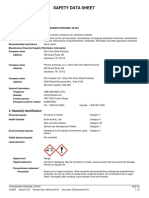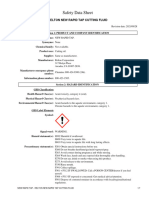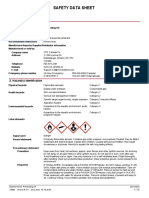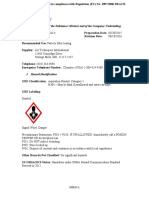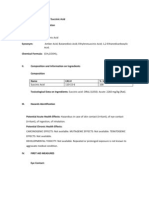Safety Data Sheet: 1. Identification
Safety Data Sheet: 1. Identification
Uploaded by
Emil LlonaCopyright:
Available Formats
Safety Data Sheet: 1. Identification
Safety Data Sheet: 1. Identification
Uploaded by
Emil LlonaOriginal Title
Copyright
Available Formats
Share this document
Did you find this document useful?
Is this content inappropriate?
Copyright:
Available Formats
Safety Data Sheet: 1. Identification
Safety Data Sheet: 1. Identification
Uploaded by
Emil LlonaCopyright:
Available Formats
SAFETY DATA SHEET
1. Identification
Product identifier ProChlo, Calcium Hypochlorite
Other means of identification
SDS number -
Recommended use Disinfection is swimming pools and drinking water, treatment of industrial cooling water,
slime control, odor control, sewage and waste water treatment.
Recommended restrictions Use in accordance with supplier's recommendations.
Manufacturer/Importer/Supplier/Distributor information
Company name F2 Industries, LLC
Address 5543 Edmondson Pike # 156
Nashville, TN, 37211 USA
Telephone 615-459-4620
E-mail reb@f2ind.com
Website www.f2ind.com
Contact person William “Reb” Ferrell
Emergency Telephone For Hazardous Materials [or Dangerous Goods] Incidents ONLY
(spill, leak, fire, exposure or accident), call CHEMTREC at
CHEMTREC®, USA: 001 (800) 424-9300
CHEMTREC®, Canada: 001 (703) 527-3887
2. Hazard(s) identification
Physical hazards Oxidizing solids Category 2
Health hazards Acute toxicity, oral Category 4
Skin corrosion/irritation Category 1B
Serious eye damage/eye irritation Category 1
Specific target organ toxicity, single exposure Category 3 (Respiratory Tract irritation)
Environmental hazards Hazardous to the aquatic environment, acute Category 1
hazard
Hazardous to the aquatic environment, Category 1
long-term hazard
OSHA defined hazards Not classified.
Label elements
Signal word Danger
Hazard statement May intensify fire; oxidizer. Harmful if swallowed. Causes severe skin burns and eye damage.
May cause respiratory irritation. Very toxic to aquatic life with long lasting effects.
Precautionary statement
Prevention Keep away from heat. Keep/Store away from clothing and other combustible materials. Take any
precaution to avoid mixing with combustibles. Use only outdoors or in a well-ventilated area. Do
not breathe mist or vapor. Wash thoroughly after handling. Wear protective gloves/protective
clothing/eye protection/face protection. Do not eat, drink or smoke when using this product.
Avoid release to the environment.
Response In case of fire: Use water for extinction. If swallowed: Rinse mouth. Do NOT induce vomiting. If on
skin (or hair): Take off immediately all contaminated clothing. Rinse skin with water/shower. Wash
contaminated clothing before reuse. If in eyes: Rinse cautiously with water for several minutes.
Remove contact lenses, if present and easy to do. Continue rinsing. If inhaled: Remove person to
fresh air and keep comfortable for breathing. Immediately call a poison center/doctor. If exposed:
Call a poison center/doctor. Collect spillage.
ProChlo, Calcium Hypochlorite 65% SDS US
Revision date: 20-March-2015 Issue date: 20-March-2015 1/5
Storage Store locked up. Store in a well-ventilated place. Keep container tightly closed.
Disposal Dispose of contents/container in accordance with local/regional/national/international regulations.
Hazard(s) not otherwise None known.
classified (HNOC)
3. Composition/information on ingredients
Substances
Chemical name CAS number %
Calcium Hypochlorite 7778-54-3 >65
Calcium Chlorate 10137-74-3 <2
Calcium Carbonate 471-34-1 <2
Calcium Hydroxide 1305-62-0 <2
Sodium Chloride 7647-14-5 <17
Composition comments All concentrations are in percent by weight unless ingredient is a gas. Gas concentrations are in
percent by volume.
4. First-aid measures
Inhalation Remove source of contamination or move victim to fresh air. If breathing has stopped, trained
personnel should begin artificial respiration or, if the heart has stopped start CPR
(cardiopulmonary resuscitation). Get medical attention immediately.
Skin contact Take off immediately all contaminated clothing. Immediately flush skin with plenty of water.
Wash contaminated clothing before reuse.
Eye contact Immediately flush with plenty of lukewarm water for up to 20 minutes. Remove any contact
lenses and open eyelids wide apart. Continue rinsing. Take care not to raise contaminated
water into affected eye. Get medical attention immediately.
Ingestion Never give anything by mouth if victim is rapidly losing consciousness, or if unconscious or
convulsing. Have victim rinse mouth thorough with water. Have victim drum one cup (240-300ml
8-10 oz) to dilute material in stomach. Do not induce vomiting. If vomiting occurs naturally, rinse
mouth and repeat administration of water. If breathing has stopped, trained personnel should
begin artificial respiration or, if the heart has stopped cardiopulmonary resuscitation (CPR)
immediately. Get medical attention immediately.
5. Fire-fighting measures
Means of Extinction: Drench with water and cool surrounding products with water. Water in contact with hot hypochlorite
can release hydrochloric acid or chlorine gas. Use appropriate self-fire extinguishing agents – Use
water only.
Flash Point and Methods of Determination: Not combustible (does not burn). Be aware that Calcium
Hypochlorite can decompose violently at temperatures above 150° C. Releasing heat and oxygen
gas.
Upper Flammable Limit: Not applicable.
Lower Flammable Limit: Not applicable.
Auto Ignition temperature: Not applicable.
Hazardous combustions Oxygen, Chlorine and Chlorine Monoxide
products:
Protective Equipment: In case of fire wear self-contained breathing apparatus. Use personal protective.
ProChlo, Calcium Hypochlorite 65% SDS US
Revision date: 20-March-2015 Issue date: 20-March-2015 2/5
6. Accidental release measures
Personal precautions: In case of violent reaction and ignition, ensure proper and adequate ventilation and remove all the
resources of ignition. Use personal protective requirement and evacuate people to safe areas.
Environmental Precautions: Ensure the production does not enter the drains and do not allow the material to contaminate
ground water systems.
Methods of Clean up: Protect from contamination and ensure the disposal is done promptly into the suitable containers.
7. Handling and storage
Precautions for safe handling: Avoid generation dust. Avoid mixing pure material with contaminated material. Use smallest
possible amounts in designated areas with adequate ventilation.
Conditions for safe storage: Store in original containers. Keep container tightly closed in a clean, cool, open and well-
ventilated place. Keep out of sun.
8. Exposure controls/personal protection
Engineering Controls: Local exhaust ventilation required when exposure to dust occurs.
Precautions/Procedure Restrict access to area until completion of clean up.
In case of spill:
Personal Protective Equipment:
Respiration Protection: Wear dust mask or NIOSH approved type canister type respirator suitable for chlorine.
Eye/Face Protection: Chemical safety goggles, face shields are necessary.
Skin Protection: Use impervious gloves, body suite, boots, and/or other resistant protective clothing. Have safety
shower/eye wash fountain readily available in the immediate work area.
Materials for Protective Butyl rubber, natural rubber, neoprene, nitrile/polyvinyl chloride, polyurethane, polyvinyl chloride.
Clothing:
9. Physical and chemical properties
Physical state Solid granules
Appearance Form White, free flowing granules with a strong chlorine odor.
Odor threshold Not available.
pH 11.5 (5% Solution)
Specific gravity 2.050 – 2.20 @ 20°C (Water = 1@4 °C)
Melting point/freezing point Decomposes at temperature above 150°C
Boiling point Not available.
Vapor Pressure Not available.
Vapor Density Not available.
Evaporation Rate Not available.
10. Stability and reactivity
Reactivity Calcium Hypochlorite should be kept away from household soap, paint products, sustain lotions,
solvents, acid, beverages, lighted cigarettes, combustible material, garbage, dirt, rags, organic
material and other pool chemicals. Mixing with any of the above material can initiate a hazardous
decomposition of Calcium Hypochlorite. Calcium Hypochlorite should not be mixed with anything but
water.
Chemical Instability Heat, acids, and organic compounds may cause hazardous decomposition of Calcium Hypochlorite.
Water added to container to container of Calcium Hypochlorite may generate enough heat to initiate
the hazardous decomposition of material.
Ammonia, Urea and From reactive and toxic chloramines
conditions of reactivity
Acids Release Chlorine gas
Metal Oxides Can react violently
Hazardous Chlorine and Oxygen
decomposition
ProChlo, Calcium Hypochlorite 65% SDS US
Revision date: 20-March-2015 Issue date: 20-March-2015 3/5
Hazardous Polymerization: Does not occur.
Comments: Calcium Hypochlorite is a strong oxidizing agent. Mix only into water contamination of the product
may result in chemical reaction with generation of heat, liberation of hazardous gases and possible
fire and explosion.
11. Toxicological information
Local effects: When contacted with skid and eyes, causes services caustic burns. If inhaled the corrosive and
substances can load to a toxic edema of lungs. Symptoms may be delayed causes throat pain and
cough. Ingestion cause burns of the upper digestive and respiratory tracts if swallowed.
Acute Inhalation LC50: (rat) no mortality at 3.5 mg/l (1 hour). Slight to very low toxicity
Acute Dermal LD50: (rabbit) >1000 mg/kg. Slight to very low toxicity
Acute Oral LD50: (rat) 850 mg/kg. Slight to very low toxicity
Carcinogencity Toxicity: Not available.
Reproductive Toxicity: Not available.
Mutagencity: Not available.
12. Ecological information
Ecotoxicity LC50: 0.088mg/L996hr bluegill sunfish – very toxic to aquatic organisms. Make sure not to allow the
material contaminate the ground water system.
Environmental fate:
Mobility: Soluble.
Biodegradation: Not available.
Bioaccumulation: Not available.
Physical / Chemical:
Hydrolysis: Not available.
Photolysis: Not available.
Additional information: Not availalble.
13. Disposal considerations
Clean-up: Do not touch spilled material. Prevent material from entering sewers or confined place. Shovel into clean, dry, labeled
containers. Flush area with water. Contaminated materials may be dissolved in water, then treated with a reducing agent such as
sodium sulphite. Care should be taken while handling contaminated material due to fire risk.
Waste Disposal: Consult appropriate Federal, State/Provincial and local regulatory authorities to ascertain proper disposal
procedures. Care should be taken not to mix waste Calcium Hypochlorite with incompatible material. Calcium Hypochlorite should be
dissolved in water and the available chlorine should be treated using a reducing agent such as Sodium Sulphite.
14. Transport Information
DOT
UN number: UN3487
UN proper shipping name: Calcium Hypochlorite, Hydrated
Hazard Class: 5.1
Subsidiary risk: 8
Packing group: II
USA – RQ, Hazardous
Substance and Quantity: 10 lbs. / 4.5 kg. (Calcium Hypochlorite)
Marine Pollutant: Regular
ICAO/IATA:
UN number: UN3487
UN proper shipping name: Calcium Hypochlorite, Hydrated
Hazard Class: 5.1
Subsidiary risk: 8
Packing group: II
IMDG:
UN number UN3487
UN proper shipping name Calcium Hypochlorite, Hydrated
Class 5.1
Subsidiary risk 8
Packing group II
ProChlo, Calcium Hypochlorite 65% SDS US
Revision date: 20-March-2015 Issue date: 20-March-2015 4/5
15. Regulatory information:
EC Labeling Requirements: The product is classified and labeled in accordance with EC directives or respective
national laws.
Contains: Calcium Hypochlorite (231-908-7)
Danger Indications:
O – Oxidizing C – Corrosive N – Dangerous Environment
R8 – Contact with combustible material may cause fire.
R22 – Harmful if swallowed
R31 – Contact with acids liberates toxic gas
R34 – Causes burns
R50 – Very toxic to aquatic organisms
Safety Phrases:
S26 – In case of contact with eyes, rinse immediately with plenty of water and seek medical advice.
S45 – In case of accident or if you feel unwell, seek medical advice immediately
S61 – Avoid release to the environment. Refer to special instructions.
S36/37/39 – Wear suitable protective clothing, gloves, and eye/face protection.
S ½ – Keep locked-up and out of the reach of children.
16. Other Information:
Other Information:
UL Drinking Water Treatment Chemicals Listing- calcium hypochlorite is certified for maximum use at 13mg/L under
ANSI/NSF Standard 60.
Risk Phrases:
R8 – Contact with combustible material may cause fire.
R22 – Harmful if swallowed
R31 – Contact with acids liberates toxic gas
R34 – Causes burns
R50 – Very toxic to aquatic organisms
ProChlo, Calcium Hypochlorite 65% SDS US
Revision date: 20-March-2015 Issue date: 20-March-2015 5/5
You might also like
- 30.MSDS Hydrex 2250 SG - GHSDocument6 pages30.MSDS Hydrex 2250 SG - GHSPrabath VlogsNo ratings yet
- Lesson Plan Multigrade 1&2Document30 pagesLesson Plan Multigrade 1&2Anonymous pN9oFMD185% (13)
- Cullex Resin MSDSDocument6 pagesCullex Resin MSDSJuan ArcosNo ratings yet
- Metglas 2605S3A HFADocument2 pagesMetglas 2605S3A HFAduc100% (1)
- Material Safety Data Sheet: Product Name: Calcium Hypochlorite (Niclon 70G) Revision Date July 2016Document7 pagesMaterial Safety Data Sheet: Product Name: Calcium Hypochlorite (Niclon 70G) Revision Date July 2016郭哲宏No ratings yet
- c-130 Service New Vol. 1 Nr. 3 1974Document24 pagesc-130 Service New Vol. 1 Nr. 3 1974angelo marraNo ratings yet
- Making The GradeDocument4 pagesMaking The Gradejuancho1994No ratings yet
- Boyd BushmanDocument37 pagesBoyd BushmanBudd JohnNo ratings yet
- Material Safety Data Sheet (MSDS) Sodium Lauryl Ether Sulfate (SLES)Document11 pagesMaterial Safety Data Sheet (MSDS) Sodium Lauryl Ether Sulfate (SLES)Mohit JagtapNo ratings yet
- Hydrochloric Acid MSDS: 1. Product and Company IdentificationDocument7 pagesHydrochloric Acid MSDS: 1. Product and Company IdentificationdeaNo ratings yet
- SDS - Olin - KOH - 30 - US - SDS - US - EnglishDocument8 pagesSDS - Olin - KOH - 30 - US - SDS - US - EnglishLuis Carbajal CusiNo ratings yet
- Safety Data Sheet: 1. IdentificationDocument8 pagesSafety Data Sheet: 1. IdentificationPachomancipecNo ratings yet
- Cetyltrimethylammonium Bromide (CTAB) 1320Document6 pagesCetyltrimethylammonium Bromide (CTAB) 1320Rohmatun Nafi'ahNo ratings yet
- SafetyDataSheet (SDS) AristonicAcidH EN 06302021Document9 pagesSafetyDataSheet (SDS) AristonicAcidH EN 06302021shelmakrmNo ratings yet
- Safety Data Sheet: 1. IdentificationDocument7 pagesSafety Data Sheet: 1. IdentificationDanielNo ratings yet
- ChlorineDocument18 pagesChlorineNur Intan PratiwiNo ratings yet
- MSDS of BKC 80-UN3265Document6 pagesMSDS of BKC 80-UN3265Vinicius100% (1)
- Pioneer Forensics - PF001 - PF002 - Acetic Acid - GlacialDocument7 pagesPioneer Forensics - PF001 - PF002 - Acetic Acid - GlacialAndronikusNo ratings yet
- cas no 68424-85-1Document8 pagescas no 68424-85-1Molybdnum ChannelNo ratings yet
- Safety Data Sheet: 1. IdentificationDocument11 pagesSafety Data Sheet: 1. IdentificationANIRUDDHA KAPADNISNo ratings yet
- Calcium Chloride, Anhydrous PowderDocument5 pagesCalcium Chloride, Anhydrous PowderKoaLa AyuNdhaNo ratings yet
- Crude Oil Sour SDS PDFDocument8 pagesCrude Oil Sour SDS PDFJagjit SinghNo ratings yet
- Caustic Soda: Safety Data SheetDocument6 pagesCaustic Soda: Safety Data SheetmikeNo ratings yet
- Suhu Refluks PDFDocument8 pagesSuhu Refluks PDFdesyaniputri95No ratings yet
- Safety Data Sheet: 1. IdentificationDocument8 pagesSafety Data Sheet: 1. IdentificationCelsoJungtonNo ratings yet
- Sds - Rain Shine AzulDocument10 pagesSds - Rain Shine AzulVictor Rodriguez SotoNo ratings yet
- LPS-3 Primier Rust InhibitorDocument10 pagesLPS-3 Primier Rust InhibitorTariqNo ratings yet
- Triethylene Glycol: Safety Data SheetDocument6 pagesTriethylene Glycol: Safety Data SheetMohd Shareen Ezzry Mohd SomNo ratings yet
- Safety Data Sheet: 1. Identification of The Substance/Preparation and of The Company Decant OilDocument11 pagesSafety Data Sheet: 1. Identification of The Substance/Preparation and of The Company Decant OilZakyAlFatonyNo ratings yet
- 235 - GHS Disinfectant Hospital Grade - 0916 PDFDocument6 pages235 - GHS Disinfectant Hospital Grade - 0916 PDFskype2121No ratings yet
- Raw 01 PVC Flexible Clear Cement SDS CA ENG 001Document10 pagesRaw 01 PVC Flexible Clear Cement SDS CA ENG 001jpcc1986No ratings yet
- Relton New Rapid Tap Cutting FluidDocument7 pagesRelton New Rapid Tap Cutting FluidCarlos Daniel Guzman GuerraNo ratings yet
- Raw SDS US Oatey PVCHDGrayFastSet 00390 7390Document10 pagesRaw SDS US Oatey PVCHDGrayFastSet 00390 7390nikos.a.kyriakouNo ratings yet
- Hydrochloric Acid 22 Baume 35 37 English 2017Document7 pagesHydrochloric Acid 22 Baume 35 37 English 2017Nitika SinhaNo ratings yet
- Hydrogen Peroxide 10 2512Document6 pagesHydrogen Peroxide 10 2512Ren TanamaNo ratings yet
- Lead OctoateDocument10 pagesLead OctoateCristian castroNo ratings yet
- Muriatic Acid MsdsDocument6 pagesMuriatic Acid MsdsChe Gu BadriNo ratings yet
- Breaker Encap KP-XHT SDSDocument6 pagesBreaker Encap KP-XHT SDSNinaNo ratings yet
- Croc Bloc HD Insect RepellantDocument8 pagesCroc Bloc HD Insect RepellantPubcrawlNo ratings yet
- Raw - 01 Oatey CPVCHeavyDutyOrangeandGray SSDS CA ENG 01Document9 pagesRaw - 01 Oatey CPVCHeavyDutyOrangeandGray SSDS CA ENG 01Arleth Nahomi Guevara MarcosNo ratings yet
- Motor Medic 100063218 SdsDocument9 pagesMotor Medic 100063218 SdsKalpeshNo ratings yet
- Safety Data Sheet: 1. IdentificationDocument9 pagesSafety Data Sheet: 1. IdentificationU.s. Ezhil ArivudainambiNo ratings yet
- Safety Data Sheet: Section 1. IdentificationDocument10 pagesSafety Data Sheet: Section 1. IdentificationToghrul dddNo ratings yet
- Trans X SDSDocument12 pagesTrans X SDSNathanNo ratings yet
- Safety Data Sheet: 1. IdentificationDocument9 pagesSafety Data Sheet: 1. IdentificationAndini Nur PaujiahNo ratings yet
- MSDSDocument3 pagesMSDSYash KayasthNo ratings yet
- Diesel Addidative - ABRO Diesel Injector Cleaner DL-502Document12 pagesDiesel Addidative - ABRO Diesel Injector Cleaner DL-502Pankaj RanjanNo ratings yet
- SDS Canada - PVC Regular Clear CementDocument10 pagesSDS Canada - PVC Regular Clear CementFernando MayhuaNo ratings yet
- Sulfuric Acid NitrateDocument10 pagesSulfuric Acid NitrateAliNo ratings yet
- Safety Data Sheet: Section 1. IdentificationDocument12 pagesSafety Data Sheet: Section 1. IdentificationDogamNo ratings yet
- Vinyl Toluene - SDS EnglishDocument8 pagesVinyl Toluene - SDS English2966338690No ratings yet
- Light Cycle Oil LcoDocument13 pagesLight Cycle Oil LcoPRASENJIT CHAKRABORTYNo ratings yet
- Hydrogen Peroxide, 10% (W/W) : Safety Data SheetDocument6 pagesHydrogen Peroxide, 10% (W/W) : Safety Data SheetFebrianca KharismaNo ratings yet
- Nipacide MX: Safety Data SheetDocument6 pagesNipacide MX: Safety Data SheetJonathan MartinezNo ratings yet
- Manufacturer SDSDocument10 pagesManufacturer SDSJack AultNo ratings yet
- AK0114MSDocument4 pagesAK0114MSjaime baezaNo ratings yet
- Safety Data Sheet: 1. IdentificationDocument10 pagesSafety Data Sheet: 1. IdentificationAnthony Lloyd WattonNo ratings yet
- ATI-PAO-Safety Data Sheet in Compliance With RegulationDocument7 pagesATI-PAO-Safety Data Sheet in Compliance With RegulationGochepz Shanz0% (1)
- MSDS UnitizerDocument5 pagesMSDS UnitizerDendi Pradeep ReddyNo ratings yet
- MSDSDocument38 pagesMSDSKim Marie TabernillaNo ratings yet
- Raw 01 Rain-RShineBluePVCCement SDS 001Document10 pagesRaw 01 Rain-RShineBluePVCCement SDS 001Matt Mayo SanchezNo ratings yet
- MSDS-Hydrochloric AcidDocument8 pagesMSDS-Hydrochloric AciddaniNo ratings yet
- Aquatrol 362: Safety Data SheetDocument6 pagesAquatrol 362: Safety Data SheetsitimaezyarohNo ratings yet
- CRW9152A CORROSION INHIBITORDocument14 pagesCRW9152A CORROSION INHIBITORMolybdnum ChannelNo ratings yet
- Java Database Programming With JDBCDocument214 pagesJava Database Programming With JDBCNimra WaqarNo ratings yet
- Tapping Into Your Fullest PotentialDocument4 pagesTapping Into Your Fullest Potentialscottsdaleduilawyer100% (1)
- Naa Anubhavam 13 21Document60 pagesNaa Anubhavam 13 21Hotest Wheels72% (18)
- Fake News DetectionDocument44 pagesFake News Detectionaravind100% (1)
- Thermit Welding: S.Shanmugasundaram at Venkadesh KaraikalDocument15 pagesThermit Welding: S.Shanmugasundaram at Venkadesh KaraikalAnonymous Zx7EG1PaNo ratings yet
- How To Pray The RosaryDocument2 pagesHow To Pray The RosaryArleen CarabbacanNo ratings yet
- Catalogue - JiangyinSpark-kellyDocument32 pagesCatalogue - JiangyinSpark-kellyMulcue ProfeNo ratings yet
- Summarry of Modules 2 and 4Document9 pagesSummarry of Modules 2 and 4Jaquias Calelao AlfredNo ratings yet
- CW10 Poems 1Document6 pagesCW10 Poems 1Antoinette San JuanNo ratings yet
- Industrial Single Board Computer: Express MotherboardDocument2 pagesIndustrial Single Board Computer: Express MotherboardARTURO DE LA VEGANo ratings yet
- An Ancient Remedy RediscoveredDocument3 pagesAn Ancient Remedy RediscoveredVladimir ArmijosNo ratings yet
- Parlour Pellet ManualDocument29 pagesParlour Pellet ManualAmândio PintoNo ratings yet
- Lecture 5Document39 pagesLecture 5Ishtiaq AhmedNo ratings yet
- An Spss Case StudyDocument8 pagesAn Spss Case StudyVenkata Ramana MurthyNo ratings yet
- Man of The HouseDocument1 pageMan of The HouseskateboardingissexyNo ratings yet
- Kers Will 2004 Social Dialect Ology PDFDocument20 pagesKers Will 2004 Social Dialect Ology PDFNajla BA50% (2)
- Automatic Configuration of NSGA-II With Jmetal and IraceDocument8 pagesAutomatic Configuration of NSGA-II With Jmetal and IracedrsreekumarNo ratings yet
- Ray Theory Transmission in Optical FibersDocument27 pagesRay Theory Transmission in Optical FibersvardhanNo ratings yet
- Eng 302lesson1-2023Document24 pagesEng 302lesson1-2023Fedil TinaNo ratings yet
- SGS Secured in TJ 5601 22084 Electric Original ReportDocument10 pagesSGS Secured in TJ 5601 22084 Electric Original ReportUsman NadeemNo ratings yet
- MỞ RỘNG KIẾN THỨC SGK K12Document33 pagesMỞ RỘNG KIẾN THỨC SGK K12Lan Anh NguyễnNo ratings yet
- 8 BP WEEK 6 - Create FlowchartDocument9 pages8 BP WEEK 6 - Create FlowchartKathrine CadalsoNo ratings yet
- Final Research Changed2Document62 pagesFinal Research Changed2W SNo ratings yet
- Unit 2 Advanced Operating Systems 23pcsce24!3!1Document17 pagesUnit 2 Advanced Operating Systems 23pcsce24!3!1Friends of GADGETSNo ratings yet
- WorkshopDocument5 pagesWorkshopJoseph NjugunaNo ratings yet










